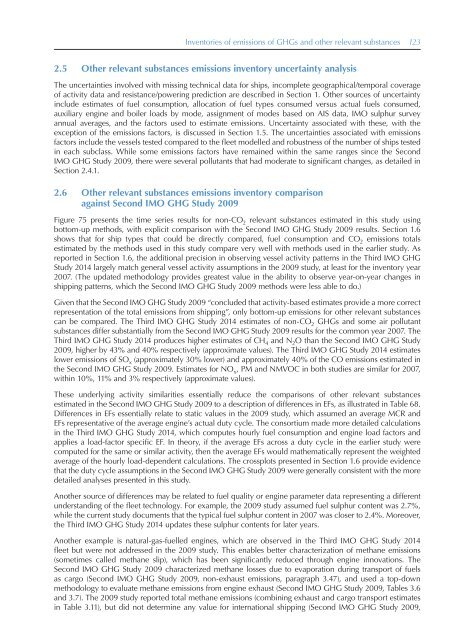Third IMO Greenhouse Gas Study 2014
GHG3%20Executive%20Summary%20and%20Report
GHG3%20Executive%20Summary%20and%20Report
You also want an ePaper? Increase the reach of your titles
YUMPU automatically turns print PDFs into web optimized ePapers that Google loves.
Inventories of emissions of GHGs and other relevant substances 123<br />
2.5 Other relevant substances emissions inventory uncertainty analysis<br />
The uncertainties involved with missing technical data for ships, incomplete geographical/temporal coverage<br />
of activity data and resistance/powering prediction are described in Section 1. Other sources of uncertainty<br />
include estimates of fuel consumption, allocation of fuel types consumed versus actual fuels consumed,<br />
auxiliary engine and boiler loads by mode, assignment of modes based on AIS data, <strong>IMO</strong> sulphur survey<br />
annual averages, and the factors used to estimate emissions. Uncertainty associated with these, with the<br />
exception of the emissions factors, is discussed in Section 1.5. The uncertainties associated with emissions<br />
factors include the vessels tested compared to the fleet modelled and robustness of the number of ships tested<br />
in each subclass. While some emissions factors have remained within the same ranges since the Second<br />
<strong>IMO</strong> GHG <strong>Study</strong> 2009, there were several pollutants that had moderate to significant changes, as detailed in<br />
Section 2.4.1.<br />
2.6 Other relevant substances emissions inventory comparison<br />
against Second <strong>IMO</strong> GHG <strong>Study</strong> 2009<br />
Figure 75 presents the time series results for non-CO 2 relevant substances estimated in this study using<br />
bottom-up methods, with explicit comparison with the Second <strong>IMO</strong> GHG <strong>Study</strong> 2009 results. Section 1.6<br />
shows that for ship types that could be directly compared, fuel consumption and CO 2 emissions totals<br />
estimated by the methods used in this study compare very well with methods used in the earlier study. As<br />
reported in Section 1.6, the additional precision in observing vessel activity patterns in the <strong>Third</strong> <strong>IMO</strong> GHG<br />
<strong>Study</strong> <strong>2014</strong> largely match general vessel activity assumptions in the 2009 study, at least for the inventory year<br />
2007. (The updated methodology provides greatest value in the ability to observe year-on-year changes in<br />
shipping patterns, which the Second <strong>IMO</strong> GHG <strong>Study</strong> 2009 methods were less able to do.)<br />
Given that the Second <strong>IMO</strong> GHG <strong>Study</strong> 2009 “concluded that activity-based estimates provide a more correct<br />
representation of the total emissions from shipping”, only bottom-up emissions for other relevant substances<br />
can be compared. The <strong>Third</strong> <strong>IMO</strong> GHG <strong>Study</strong> <strong>2014</strong> estimates of non-CO 2 GHGs and some air pollutant<br />
substances differ substantially from the Second <strong>IMO</strong> GHG <strong>Study</strong> 2009 results for the common year 2007. The<br />
<strong>Third</strong> <strong>IMO</strong> GHG <strong>Study</strong> <strong>2014</strong> produces higher estimates of CH 4 and N 2 O than the Second <strong>IMO</strong> GHG <strong>Study</strong><br />
2009, higher by 43% and 40% respectively (approximate values). The <strong>Third</strong> <strong>IMO</strong> GHG <strong>Study</strong> <strong>2014</strong> estimates<br />
lower emissions of SO x (approximately 30% lower) and approximately 40% of the CO emissions estimated in<br />
the Second <strong>IMO</strong> GHG <strong>Study</strong> 2009. Estimates for NO x , PM and NMVOC in both studies are similar for 2007,<br />
within 10%, 11% and 3% respectively (approximate values).<br />
These underlying activity similarities essentially reduce the comparisons of other relevant substances<br />
estimated in the Second <strong>IMO</strong> GHG <strong>Study</strong> 2009 to a description of differences in EFs, as illustrated in Table 68.<br />
Differences in EFs essentially relate to static values in the 2009 study, which assumed an average MCR and<br />
EFs representative of the average engine’s actual duty cycle. The consortium made more detailed calculations<br />
in the <strong>Third</strong> <strong>IMO</strong> GHG <strong>Study</strong> <strong>2014</strong>, which computes hourly fuel consumption and engine load factors and<br />
applies a load-factor specific EF. In theory, if the average EFs across a duty cycle in the earlier study were<br />
computed for the same or similar activity, then the average EFs would mathematically represent the weighted<br />
average of the hourly load-dependent calculations. The crossplots presented in Section 1.6 provide evidence<br />
that the duty cycle assumptions in the Second <strong>IMO</strong> GHG <strong>Study</strong> 2009 were generally consistent with the more<br />
detailed analyses presented in this study.<br />
Another source of differences may be related to fuel quality or engine parameter data representing a different<br />
understanding of the fleet technology. For example, the 2009 study assumed fuel sulphur content was 2.7%,<br />
while the current study documents that the typical fuel sulphur content in 2007 was closer to 2.4%. Moreover,<br />
the <strong>Third</strong> <strong>IMO</strong> GHG <strong>Study</strong> <strong>2014</strong> updates these sulphur contents for later years.<br />
Another example is natural-gas-fuelled engines, which are observed in the <strong>Third</strong> <strong>IMO</strong> GHG <strong>Study</strong> <strong>2014</strong><br />
fleet but were not addressed in the 2009 study. This enables better characterization of methane emissions<br />
(sometimes called methane slip), which has been significantly reduced through engine innovations. The<br />
Second <strong>IMO</strong> GHG <strong>Study</strong> 2009 characterized methane losses due to evaporation during transport of fuels<br />
as cargo (Second <strong>IMO</strong> GHG <strong>Study</strong> 2009, non-exhaust emissions, paragraph 3.47), and used a top-down<br />
methodology to evaluate methane emissions from engine exhaust (Second <strong>IMO</strong> GHG <strong>Study</strong> 2009, Tables 3.6<br />
and 3.7). The 2009 study reported total methane emissions (combining exhaust and cargo transport estimates<br />
in Table 3.11), but did not determine any value for international shipping (Second <strong>IMO</strong> GHG <strong>Study</strong> 2009,


